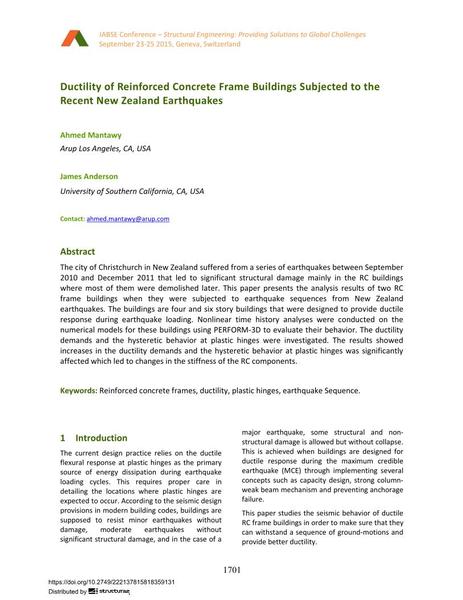Ductility of Reinforced Concrete Frame Buildings Subjected to the Recent New Zealand Earthquakes

|
|
|||||||||||
Bibliografische Angaben
| Autor(en): |
Ahmed Mantawy
(Arup Los Angeles, CA, USA)
James Anderson (University of Southern California, CA, USA) |
||||
|---|---|---|---|---|---|
| Medium: | Tagungsbeitrag | ||||
| Sprache(n): | Englisch | ||||
| Tagung: | IABSE Conference: Structural Engineering: Providing Solutions to Global Challenges, Geneva, Switzerland, September 2015 | ||||
| Veröffentlicht in: | IABSE Conference Geneva 2015 | ||||
|
|||||
| Seite(n): | 1701-1708 | ||||
| Anzahl der Seiten (im PDF): | 8 | ||||
| Jahr: | 2015 | ||||
| DOI: | 10.2749/222137815818359131 | ||||
| Abstrakt: |
The city of Christchurch in New Zealand suffered from a series of earthquakes between September 2010 and December 2011 that led to significant structural damage mainly in the RC buildings where most of them were demolished later. This paper presents the analysis results of two RC frame buildings when they were subjected to earthquake sequences from New Zealand earthquakes. The buildings are four and six story buildings that were designed to provide ductile response during earthquake loading. Nonlinear time history analyses were conducted on the numerical models for these buildings using PERFORM-3D to evaluate their behavior. The ductility demands and the hysteretic behavior at plastic hinges were investigated. The results showed increases in the ductility demands and the hysteretic behavior at plastic hinges was significantly affected which led to changes in the stiffness of the RC components. |
||||
| Stichwörter: |
Duktilität
|
||||

